In order to truly understand the implications of the changes to the measuring provisions of Section 210.8 in the 2020 National Electrical Code (NEC), one must go back and review how we arrived at that point.
Prior to the 2017 edition of the NEC, 210.8 was silent regarding how to measure the specified distances from a receptacle outlet. However, the method of measuring utilized by CMP-2 was not new to the NEC. The method had been time-tested as part of Article 680.
A change in 210.8(A) in the NEC-2014 drove the need for including the measuring language in the NEC-2017. For the 2014 edition, the text “where located in areas other than kitchens” was removed from 210.8(A)(7) so that it just read, “Sinks — where receptacles are installed within 1.8 m (6 ft) from the outside edge of the sink.”
Reviewing the history of 210.8(A)(7) reveals that originally, the requirement was just for receptacles installed within 6 feet of wet bar sinks. The text first appeared in the 1999 NEC and remained unchanged, other than adding the metric measurements, until the 2005 NEC. In the 2005 edition, the text was expanded to include receptacle outlets within 6 feet of laundry and utility sinks along with wet bar sinks. In the 2011 edition, the specific references were removed, and the text was revised to include all sink locations other than kitchens. Receptacle outlets within 6 feet of kitchen sinks were already covered as they were installed at kitchen counters. At that time, 210.8(A)(6) required all receptacle outlets serving countertop surfaces in dwelling unit kitchens to be GFCI protected.
During the 2014 NEC cycle, a public proposal identified a situation where a receptacle outlet could be located within 1.8 m (6 ft) of a kitchen sink and not require GFCI protection. The proposal described a condition where a computer workstation was attached at the end of the kitchen countertop work surface and was less than 1.8 m (6 ft) from the kitchen sink. Because the workstation was not considered a “kitchen countertop work surface,” technically, no GFCI protection was required. However, the shock hazard was the same if an appliance was used on the surface of the workstation.
Because the 2014 text did not include a reference to the “top outside edge” of the sink as being the measuring point, it became unclear as to what part of the sink the measurement was taken from. Did this change now include receptacles located in cabinets under kitchen sinks? Remember, the previous edition of the NEC only included receptacle outlets that served kitchen countertop surfaces, so a receptacle installed in a cabinet under a kitchen sink was clearly not required to be provided with GFCI protection, nor was it ever considered by many. Therefore, before the 2014 edition of the NEC, no one considered the receptacle outlet located in a cabinet for a cord- and plug-connected disposal.
Due to the lengthy discussions during the 2017 revision cycle on how measurements were made, and where they were made from, text was added to 210.8(A)(7) indicating that measurements were taken from the top inside edge of the bowl of the sink. Additionally, a new second paragraph was added to 210.8 clarifying that measurements were not made through a floor, wall, ceiling, or fixed barrier or passing through a door, doorway or window. This concept was consistent with the text of Sections 400.10(2) and (3), which prohibited flexible cords from passing through holes in walls, ceilings, and floors or from passing through doorways, windows, or similar openings.
Although the CMP-2 discussions were mainly related to cords not passing through cabinet door openings, it was not clear to all readers of the NEC that the term “doorways” was to include cabinet door openings. This was evident by the NEC-2020 public inputs requests to include “cabinet door openings” in the list of items that measurements were not made through. It was also interesting that there were several public inputs to remove the text related to measurements as a means of requiring GFCI protection for receptacle outlets in cabinets with sinks. The sleeping dog (the receptacle outlet under the sink) was awakened!
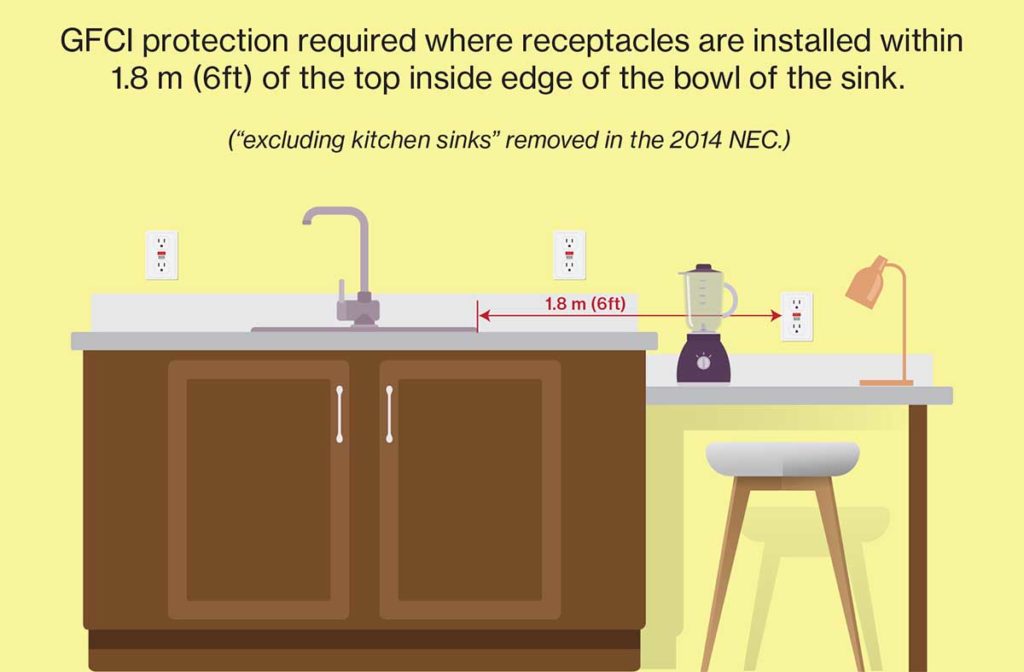
For the 2020 revision cycle, CMP-2 considered the two main concerns raised by readers of the NEC. They were that the 2017 NEC no longer had a requirement to protect receptacle outlets in cabinets under kitchen sinks and whether the term doorways included “cabinet door openings.” There were three avenues considered. One, remove all the text regarding measuring. Two, add the words “cabinet door openings” to the list of items already there and three, add the words “cabinet door openings” to the list of items you do not measure through and add a new item to 210.8(A) requiring GFCI protection for receptacle outlets located in cabinets supporting sinks. However, what passed the Second Draft Ballot was removing the words “door” and “doorway” from the list of items you do not measure through as a means of requiring GFCI protection for those receptacle outlets located in cabinets supporting sinks. Simply put, the intent of removing the reference to “door” and “doorway” was to now require a measurement to be made through them.
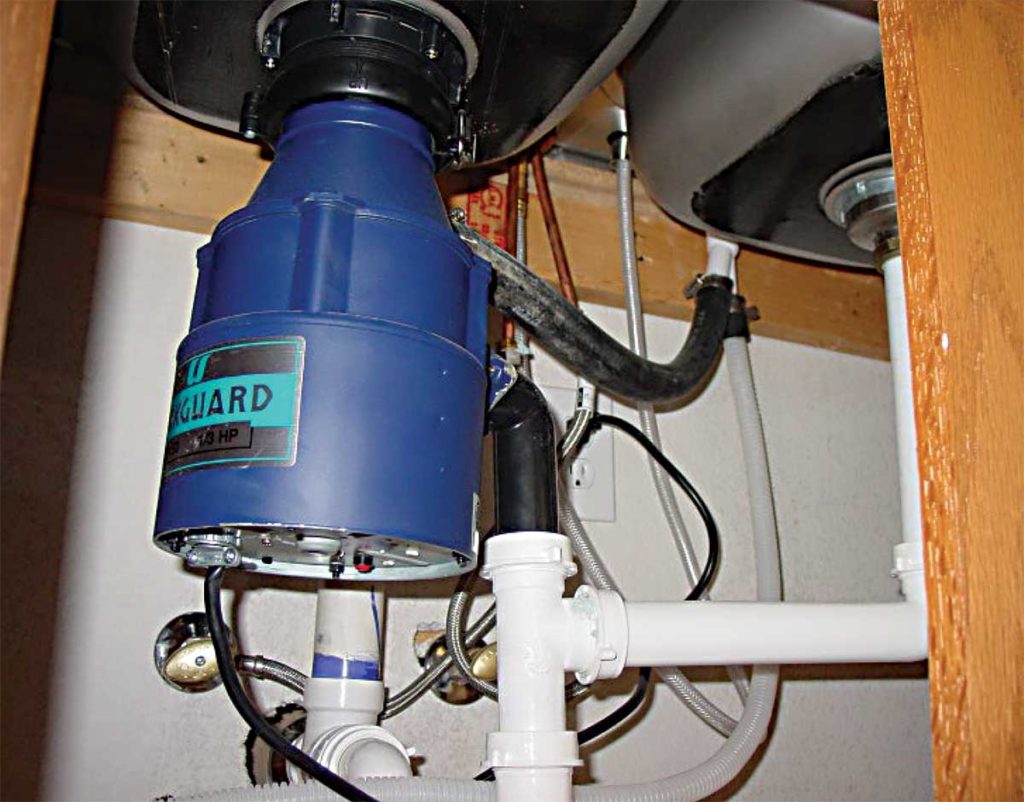
Based on the literal wording, GFCI protection would be required for receptacle outlets that are within 1.8 m (6 ft) from the top inside edge of the bowl of the sink or of the outside edge of the bathtub or shower stall whether in dwelling units or other than dwelling units as shown in Figure 2.
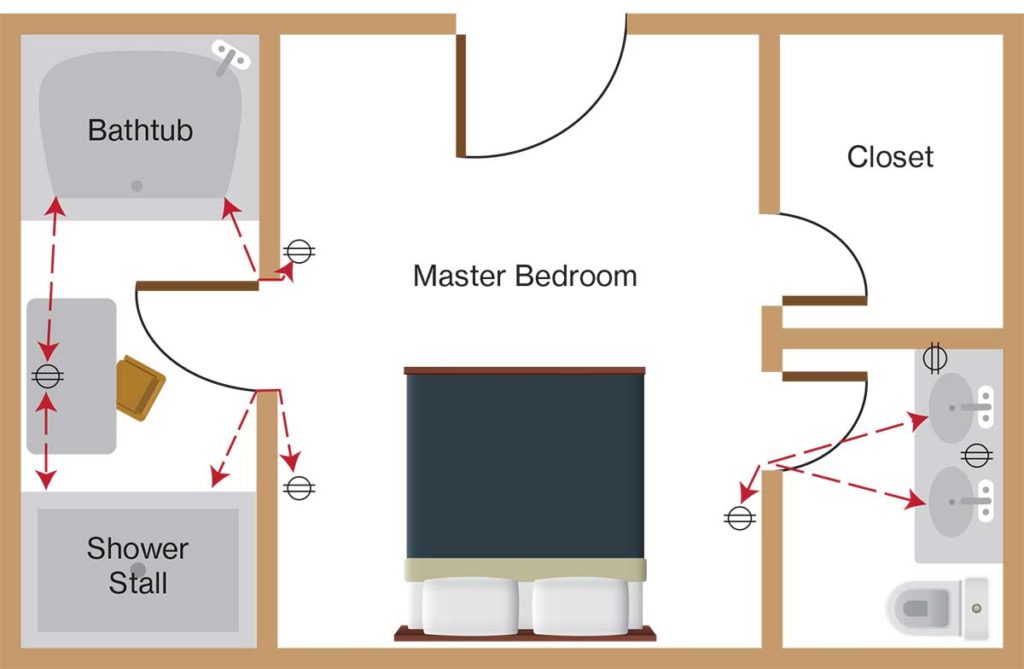
GFCI protection would also be required for receptacle outlets in cabinets that are within 1.8 m (6 ft) from the top inside edge of the bowl of the sink, including, but not limited to, dwelling units, hotels and motels, dormitories and the like. The “inside edge” is the nearest one to where the measurement is being made to or from.
Another significant change in Article 210 measurements is related to 210.52(C), Countertops and Work Surfaces. For the first draft, CMP 2 received a total of twenty-one public inputs for 210.52(C) through 210.52(C)(4). The main concern raised in these public inputs was related to where the peninsula was measured from. There were two public inputs indicating that 210.52(C) had become unnecessarily complicated and confusing and that a simple rule that results in a receptacle outlet for every 4 feet of countertop or work surface with no point on the countertop or work surface being more than 2 feet from a receptacle outlet in that space is all that is needed. Additionally, it was recognized there are kitchens that do not have a countertop or works surface wall spaces, and therefore the requirement for a single receptacle outlet was no longer enough.
CMP-2 Task Groups had considerable discussions during the First Draft meetings on simplifying the requirements, including the driving requirement of a countertop or work surface with a short dimension of 12 inches and a long dimension of 24 inches. What came out of the First Draft meetings was a driving requirement of 12 inches or wider and a requirement for countertops and work surfaces to not have a space greater than 36 inches from a receptacle outlet in that space.
CMP 2 received twelve public comments on 210.52(C) for the Second Draft Stage. From those comments, the first level titled subdivision for wall space requirements was restored, and the 36-inch requirement was revised to a square foot requirement. In the end, the countertop or work surface wall space requirements remained unchanged from the 2017 NEC, but there were significant changes to the peninsular and island requirements.
When determining the number of receptacle outlets required for island and peninsular countertops or work surfaces, one receptacle outlet must be provided for the first 0.84 m2 (9 ft2), or fraction thereof, of the countertop or work surface with an additional receptacle outlet provided for each additional 1.7 m2 (18 ft2) or fraction thereof. However, other than the requirement for one receptacle outlet to be placed within 1.7 m (2 ft) of the other end of a peninsular countertop or work surface, receptacle outlets can be located as determined by the installer, designer or building owner.
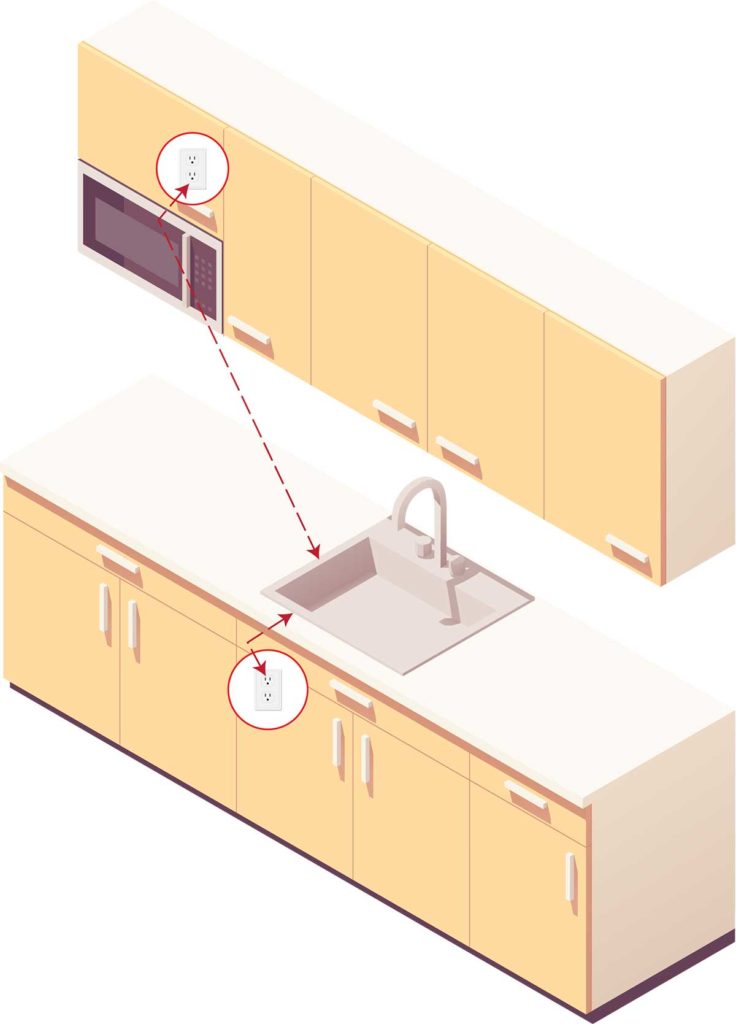
There are two methods used when considering portions of the main requirement. For example, 210.52(C) uses “or fraction thereof.” The other, not used here, is “major portion of.”
“Or fraction thereof” means less than the main requirement. For example, 210.52(C)(2)(a) states that a receptacle outlet is required for the first 9 ft2 of countertop or work surface, or fraction thereof. Therefore, any countertop or work surface 9 ft2 or less requires one receptacle outlet. Another receptacle outlet is required for each additional 18 ft2 or fraction thereof. Therefore, any countertop or work surface that is over 9 ft2 up to 27 ft2 would require an additional receptacle outlet or a minimum of two receptacle outlets total.
“Major portion of” means more than half of the original requirement. For example, 210.65 requires meeting rooms that are no more the 1000 ft2 and 12 ft or greater in any dimension to have a floor receptacle outlet or a floor outlet serving receptacles for every 215 ft2 or major portion thereof. Therefore, a meeting room that is greater than 322.5 ft2 (215 ft2 + 107.5 ft2) up to 430 ft2 would have to have two-floor outlets for receptacles.
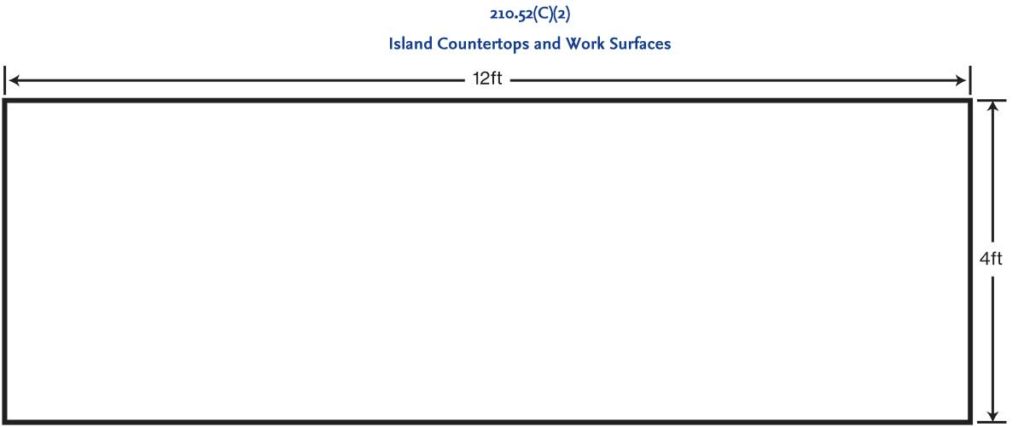
Figure 4 depicts an island countertop or work surface that is 12 ft x 4 ft (48 ft2), which would require a total of four receptacle outlets.
48 ft² – 9 ft2 = 39 ft2 = 1 receptacle outlet
39 ft²/18 ft2 = 2.17 = 3 receptacle outlets
Total = 4 receptacle outlets
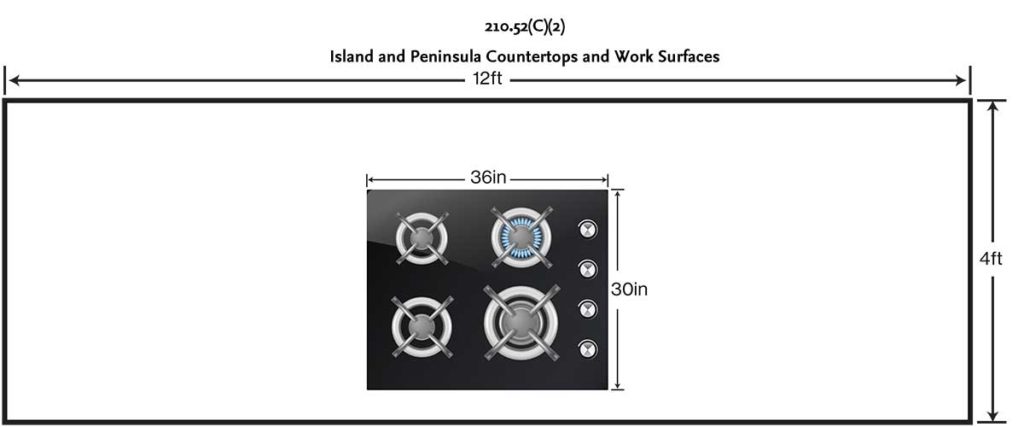
Figure 5 includes a countertop cooktop within the 48 ft2 countertop or work surface. Because the cooktop is not “countertop or work surface,” it is not included when determining the required number of receptacle outlets.
3 ft x 2.5 ft = 7.5 ft2 – cooktop
48 ft2 – 7.5 ft2 = 41.5 ft2
41.5 ft2 – 9 ft2 = 32.5 ft2 = 1 receptacle outlet
32.5 ft2/18 ft2 = 1.8 = 2 receptacle outlets
Total = 3 receptacle outlets
Because the peninsular is measured from the perpendicular wall, the receptacle outlet at the wall location can serve the peninsular countertop or work surface. However, at least one receptacle outlet must be located within 2 ft of the outer end of the peninsular.
3 ft x 8 ft = 24 ft²
24 ft² – 9 ft² = 15 ft² – 1 receptacle outlet
15 ft² remaining = 1 receptacle outlet
Total = 2 receptacle outlets
In this example, the wall receptacle outlet at the beginning of the peninsular and an additional receptacle outlet located within 2 ft of the outer end of the peninsular is all that is required.
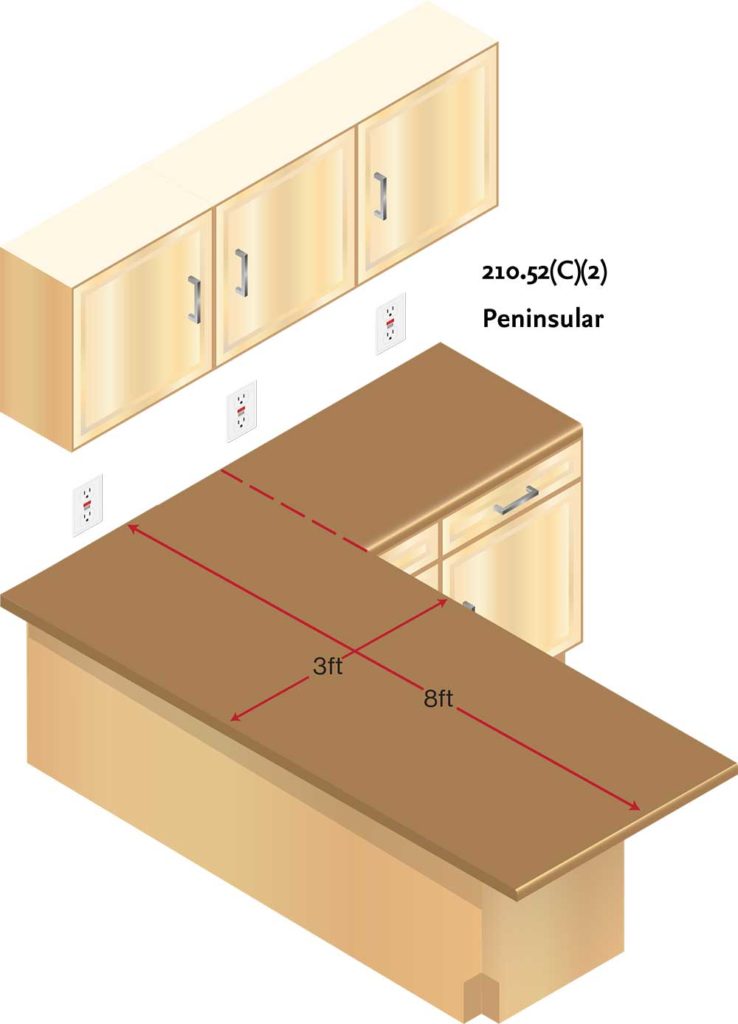
Another item that deserves recognition for the 2020 NEC, and perhaps a consideration for the 2023 NEC, is the definitions of, and differences between, the terms “receptacle outlet” and “receptacle.” The term receptacle is defined in Article 100 as “a contact device installed at the outlet… A single receptacle is a single contact device with no other contact device on the same yoke or strap. A multiple receptacle is two or more contact devices on the same yoke or strap.” The term receptacle outlet is defined as “an outlet where one or more contact devices are installed.” The term outlet is defined as “a point on the wiring system at which current is taken to supply utilization equipment.”
Based on the definition, a receptacle outlet would include a device box and receptacle(s) along with the circuit wiring. Therefore, Figure 7 would be three receptacle outlets (because there are three separate device boxes) with a total of six receptacles. The illustration to the left depicts one receptacle outlet (because there is one box) that also has a total of six receptacles. With the goal of having an increased number of receptacle outlets for the 2020 NEC being multiple locations to plug-in appliances and recognizing that multiple receptacle outlets do not require multiple branch circuits and the receptacle outlets are permitted to be located by design, hopefully practical judgment and enforcement will be the order of the day. As an installer, I would rather cut one hole in an island or peninsular cabinet than having to cut two or more just to be technically correct. As an enforcer, I would not want to have to ask an installer to cut multiple holes where doing so would not add additional safety.

Realizing that a multioutlet assembly was one receptacle outlet with one or more receptacles and that they are often installed under a cabinet, countertop or work surface, CMP 2 added text to permit them to be considered as multiple receptacle outlets. For the purposes of 210.52(C), each 300 mm (12 in) of a multioutlet assembly containing two or more receptacles in individual or continuous lengths is considered as one receptacle outlet. So, a 24-inch multioutlet assembly with four or more receptacles would be considered as two receptacle outlets.

Perhaps similar language (e.g. for the purposes of this section, where a single device box contains two or more duplex receptacles each duplex receptacle shall be permitted to be considered as one receptacle outlet) could be added to the 2023 NEC to permit a single box with multiple duplex receptacles to be considered as more than one receptacle outlet.
Want to test out your knowledge of the 2020 NEC changes for dwelling units? Take this issue’s Code Hunter quiz!





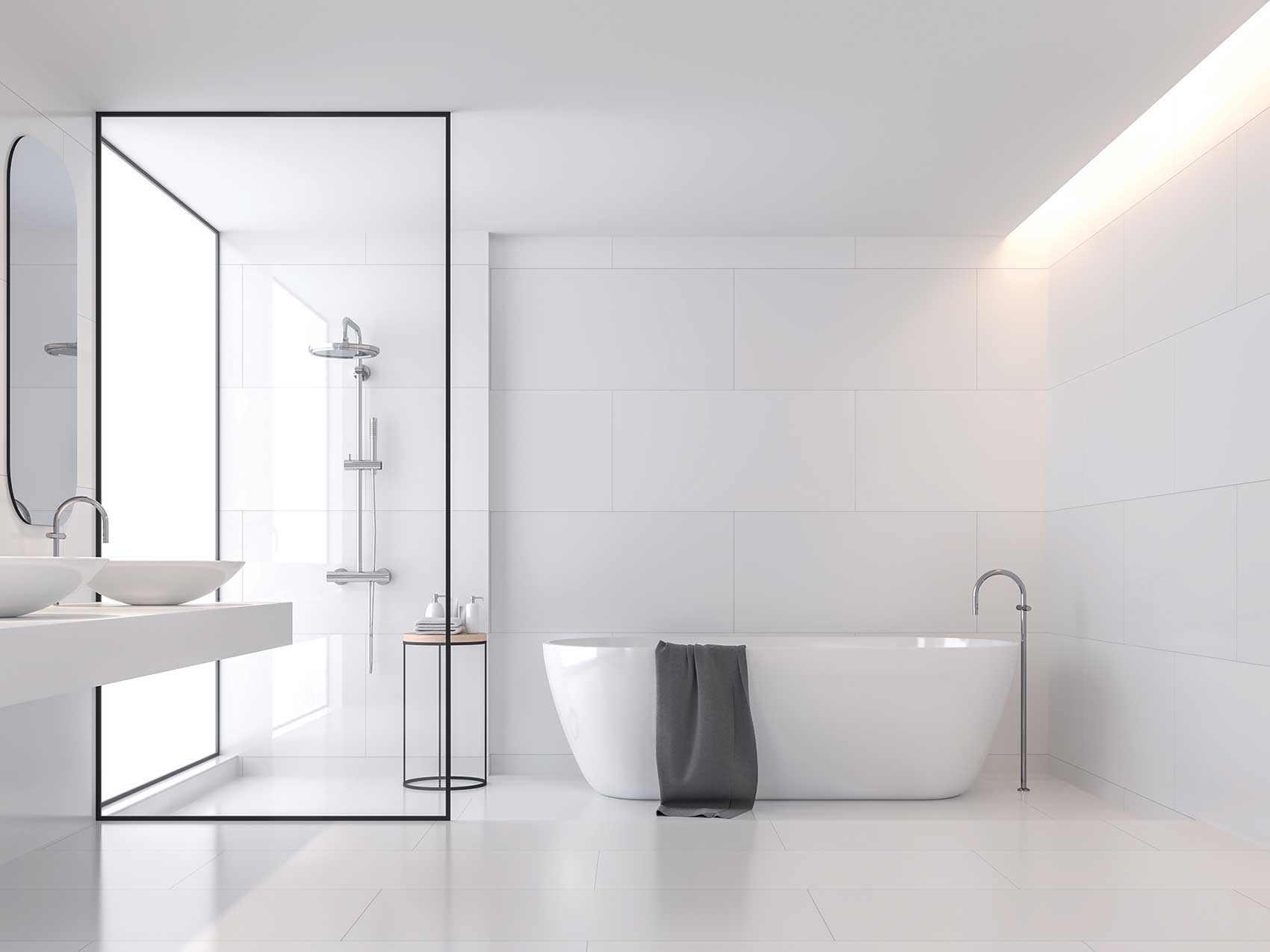






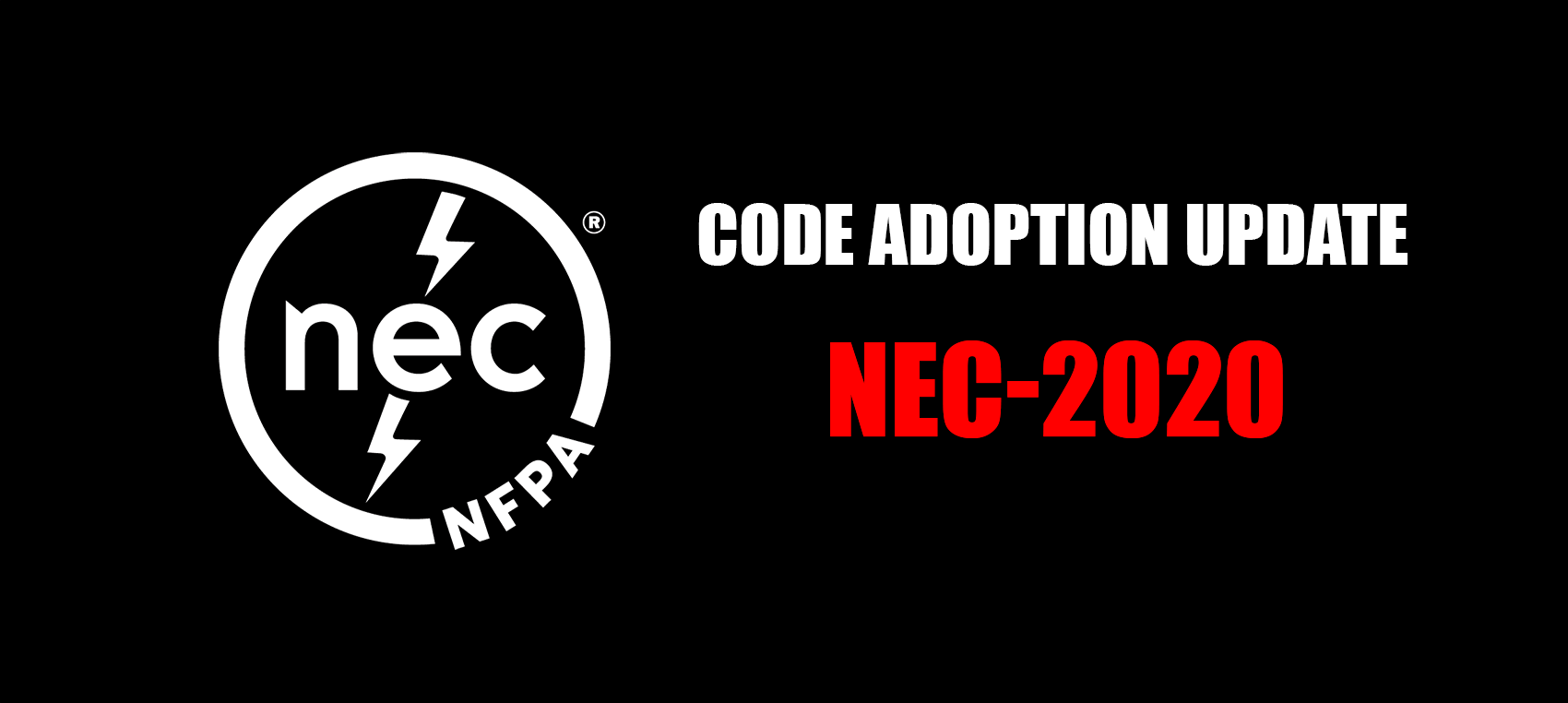
Find Us on Socials